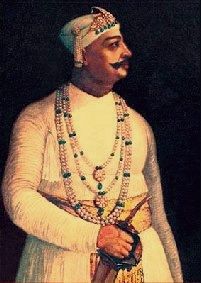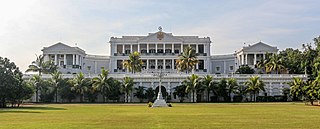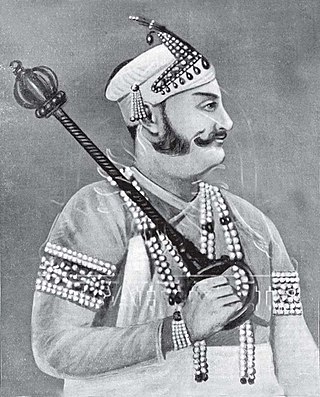
Asaf Jah VI, also known as Sir Mir Mahboob Ali Khan Siddiqi Bayafandi, was the 6th Nizam of Hyderabad. He ruled Hyderabad State, one of the princely states of India, between 1869 and 1911.

Begumpet is an upscale locality of Hyderabad, Telangana, India. Begumpet is named after the daughter of the sixth Nizam, Basheer Unnisa Begum, who received it as part of her wedding dowry when she was married to the second Amir of Paigah Shams ul Umra Amir e Kabir.

Paigah family was a noble family from the former Hyderabad State. The family maintained their own court, individual palaces, and a standing army of about fourteen thousand infantry and cavalry troops.

Nawab Mir Akbar Ali Khan Siddiqi Bahadur, Sikander Jah, Asaf Jah III, was the 6th Nizam/Ruler of Hyderabad, India from 1803 to 1829. He was born in Chowmahalla Palace in the Khilwath, the second son of Asaf Jah II and Tahniat un-nisa Begum.

Shamshabad is a town in the Indian state of Telangana. It is located in Shamshabad mandal of Rajendranagar revenue division. Sri Vendikonda Siddalingeshwara Devastanam temple is situated in Siddulagutta Road in Shamshabad mandal. The international airport of Hyderabad is located here.

Vikarabad is a town and mandal in Vikarabad district of the Indian state of Telangana. It is located in Vikarabad mandal of Vikarabad revenue division.

Falaknuma is a palace in Hyderabad, Telangana, India. It originally belonged to the Paigah family, and was later owned by the Nizam of Hyderabad. It is on a hillock and covers a 13-hectare (32-acre) area in Falaknuma, 5 kilometres (3.1 mi) from Charminar.

The Asaf Jahi was a Muslim dynasty that ruled the Hyderabad State. The family came to India in the late 17th century and became employees of the Mughal Empire. They were great patrons of Persian culture, language, and literature, and the family found ready patronage.

Sir Viqar ul-Umara, Iqtidar ul-Mulk, Iqbal ud-Dowla, Secundar Jung, Nawab Muhammad Fazl-ud-din Khan Bahadur, was the Prime Minister of Hyderabad from 1893 to 1901, and also served as the Amir e Paigah from 1881 to 1902.

His Excellency Amir e Paigah Basheerd-Ud-daula Azam-Ul-Umra Amir-e-Akbar Nawab Sir Muhammad Mazharuddin Khan Bahadur Rifa’at Jang, commonly known as Sir Asman Jah or Nawab Sir Asman Jah Bahadur, Asman Jah was one of those fortunate individuals to whom it has been given by fate to write their names large in the annals of their country, he was an Indian noble and member of the Great Paigah Family who served as Prime Minister of Hyderabad from 1887 to 1894. As the grandson of the premier noble Fakhr Uddin Khan Amir e Kabir Shams-ul-Umra I and of a princess of the blood, his social position was a great one; but the personal qualities he possessed, inherited largely from his grandfather, were unquestionably the means of bringing him to the front. Singularly gifted by nature as far as the outward man was concerned and excelling in all manly pursuits, he easily took the lead among his peers. But it was his mental and moral equipment which attracted the notice of his royal master while yet the young noble was in early manhood. Such was the promise he showed that His Highness the Afzal-ud-Daulah gave him his daughter in marriage and bestowed on him the highest distinction in his gift, the title of Jah.in 1869, Asman Jah entered on his public career as Minister of Justice. A little later on, while still retaining the portfolio of Justice, he acted as Prime Minister and co-regent. Later still he became a Member of the Council of Regency, and finally in 1887 he was appointed Prime Minister and continued to hold the office till 1893. In this connection it may be noted that throughout his long official career, Sir Asman Jah refused to take any salary while willing to take office he steadily persisted im refusing the emoluments of office. Elis regime as Premier was marked by several reforms, notably the advance made in education, the extension of medical aid by the State, especially aid to women, and the establishment of a permanent Board of Irrigation and city water supply, which has since been of excellent service to the State, Asman Jah was still in London when he got the news of his having been-appointed Prime Minister and one of the first to congratulate him on his appointment was his late Majesty King Edward VIL, then Prince of Wales, Asman Jah built several architectures throughout the city like Asman Garh Palace, Basheer Bagh Palace, saroonagar palace and Mahboob Chowk Clock Tower. Just before he was appointed to the premiership he was deputed by His Highness the late Nizam, Mahboob Ali Khan, to proceed in 1887 to London as his representative at the Golden Jubilee of Her late Majesty Queen Victoria. While in England he won golden opinions by the tact, savoir faire and high breeding he displayed His handsome presence, imposing address and polished manners impressed all classes of English Society and he became a great favourite in court circles. Indeed, the late Nizam could not have had a more dignified or worthier representative.

Paigah Palace is a palace in Hyderabad, India. It was built by Sir Vicar-ul-Umra, a Paigah nobleman. This was built after he gave the famous Falaknuma Palace to the sixth Nizam of Hyderabad state, Mahbub Ali Khan, Asaf Jah VI.
Bagh Lingampally is a commercial and residential neighbourhood of Hyderabad, Telangana, India. It has become one of the many major centres of Hyderabad. Lingampalli.It was earlier known as Lingampalli Bagh, which contained a royal palace with a compound of 55 acres, with 130 acres around it. Lingampalli Bagh was given as a wedding present by the 5th Nizam, Nawab Afzal-ud-Dowla Bahadur when his daughter Shehzadi Haseen unnisa married Nawab Khursheed Jah Bahadur, H.E. Paigah Amir Nawab Sir Khursheed Jah Bahadur, the second greatest Paigah nobleman of Hyderabad Deccan. A little portion of the palace remains today...in what is Ambedkar College inside Lingampalli Bagh. The bagh was acquired by the Housing Board A.P., in the sixties. Furthermore, the palace had a tunnel leading to Golconda Fort. This was a property belonging to the Nizams and was given to Haseen Unnisa Begum, wife of Sir Khursheed Jah, by her father Nawab Afzal-ud-Dowla, Asaf Jah V, at the time of her wedding. She was also the sister of H.H Nawab Mahboob Ali Khan, Asaf Jah VI. This locality was also home to one of the Nobility of Hyderabad, Khan Bahadur Abdulkareem Lal Khan, Former Kotwal in the 7th Nizams Government. This area used to be full of fruit gardens belonging to them, from where the prefix ‘Bagh' is derived. The place had a small village called Lingampally which had a tank where queens would bathe. The locality has gained importance due to its proximity to RTC X Roads, Chikkadpally, Barkatpura, Himayathnagar, Nallakunta and Koti. This suburb is a mixture of the Old and New City cultures of Hyderabad. There is a vegetable market on Saturdays.

The Spanish Mosque is a mosque within the Paigah Palace, Begumpet, Hyderabad, India.
Sarf-e-Khas are crown lands across the princely state of Hyderabad belonging to the Nizam family covering 10,000 square miles. The Dar-ul-Shifa was the headquarters for Sarf-e-Khas during the reign of Nizam II. Sarf-e-Khas land revenue and the resources were used to serve the royalty exclusively, until its merger with Indian Union in 1948. It was taken over by the Government of India after the accession and paid The Last Nizam and his family a sum of one crore per annum. The Nizam had a private army known as Sarf-e-Khas army.
Lutfuddaulah Oriental Research Institute is an Indian research institute in the state of Hyderabad. It was named after Nawab Lutf ud-Dowlah Muhammad Lutf ud-Din Khan Bahadur Latafat Jang and was founded by Hakeem Sayyid Shamsullah Qadri circa 1937.

Khursheed Jah Devdi is a European styled architectural palace located in Hyderabad. It was built by the Ancestors of Paigah noble Amir-Paigah Khursheed Jah Bahadur Shams-ul-Umra IV, Its interiors were once adorned with expensive carpets and exclusive chandeliers. The gardens blossomed with flowers and fountains making the ambiance livelier. located at Hussaini Alam, just a kilometer from the historic Charminar.

Amir-e-Paigah-e-Asman Jahi, Moin-ud-Daula Bahadur Innayath Jung, commonly known as Sir Nawab Muhammed Moin Uddin Khan born at Basheer Bagh Palace in 1891 was an Indian nobleman and member of the Paigah Nobility and the Amir of the Asman Jahi Paigah one of the 3 great Paigahs of Hyderabad State The Paigah Nobility was the second most powerful family in Deccan Hyderabad State maintaining their own court and army bound with Asaf Jahi dynasty by matrimonial relationship, Moin-ud-doula and his father Asman Jah was one of those fortunate individuals to whom it has been given by fate to write their names large in the annals of their country, Moin-ud-doula's father Asman Jah who served as co-regent and Prime Minister of Hyderabad created several marvelous architects throughout the city maintained his army court in his domain Shamshabad, was granted the title of Order of the Indian Empire,

Aiwan-i Begumpet, also known as Chiraan Fort Palace, and Devdi Fareed Nawaz Jung, or Devdi Nazir Nawaz Jung, was built in 1880 by Sir Viqar-ul-Umra, Amir of the Great Paigah Dynasty of Deccan who served as Prime Minister of Hyderabad. The palace was built after the construction of Falaknuma Palace gifted to the sixth Nizam of Hyderabad Mir Mahbub Ali Khan, Asaf Jah VI. Devdi is one of the complexes in the Paigah Palace residence house of the Paigah Nobelity, In the hierarchy of nobles of Hyderabad, the Paigah family ranked immediately next to the ruling family of Nizams.

Shams ul-Umara, Shams ul-Mulk, Shams ud-Daula, Nawab Muhammad' Abu’l Fath Khan Bahadur, Taigh Jang Bahadur ['Abu’l Khair Khan II] [Imam JungIII] was an Indian nobleman and founder of the House of Paigah.
Abu'l Fakhr Muhammad Fakhruddin Khan (1780–1863), also called Amir e KabirShams-ul-Umra I, was an Indian nobleman. He was the first member of the House of Paigah to be matrimonially allied to the House of Asaf Jah. His full name with titles was Shams ul-Umara, Amir-i-Kabir, Khurshid ul-Mulk,Khurshid ud-Daula, Nawab ‘Abu’l Fakhr Muhammad Fakhr ud-din Khan Bahadur, Imam Jang [‘Abu’l Khair Khan III]; he became The First Amir of the House of Paigah, the Paigah Amirs held the honorary monarchal (standard) behind the Nizam of Hyderabad and were the highest order nobility. Paigah members were said to be richer than average Maharajas and had their own standing army, palaces, and courts
























